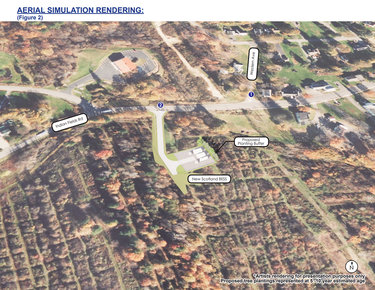Large battery storage system proposed for Feura Bush
NEW SCOTLAND — RIC Energy is seeking permission from the town of New Scotland to install a large-scale battery energy storage system on Indian Fields Road in Feura Bush.
The location is the 137-acre home of the New Scotland Beagle Club, which was incorporated in the 1950s.
The proposed project would involve the installation of five Tesla-made shipping-container-sized units — each measuring eight feet high by six feet wide and 30 feet in length — that stockpile renewable energy collected during the day and send it to the grid during peak-use evening hours.
The batteries, per RIC’s packet submission, are designed to discharge a maximum of 20,000 kilowatt-hours — roughly equivalent to the average daily electricity consumption of almost 700 homes — over a four-hour period
A kilowatt-hour is a unit of measurement that signifies the amount of energy required to keep a device consuming one kilowatt, or 1,000 watts, running for one hour. The kilowatt-hour differs from the kilowatt in that a kilowatt is a measurement of consumption; it indicates the amount of power a device needs just to kick on while the kilowatt-hour measures the total energy used over a period of time. New Scotland EES’s — the RIC LLC actually proposing the storage system — proposal is for 5,000 kilowatts, or five megawatts.
The growth of storage systems proposals can be traced back to former Governor Andrew Cuomo’s signing the 2019 Climate Leadership and Community Protection Act, which set the ambitious target of all of New York’s power coming from clean energy sources by 2040 in addition to all sectors of the state’s economy removing more greenhouse gas from the atmosphere than they release into it, a concept known as net-zero emissions.
The growth in battery storage across New York has come with unintended consequences. Most battery energy storage systems are made up of numerous lithium-ion battery cells, which often cause battery energy storage systems, or BESS, fires. A defective or damaged battery will emit a hot, flammable toxic gas that pushes more heat into the system, which eventually leads to a fire or explosion.
In response to a series of fires at BESS locations across the state during the summer of 2023, Governor Kathy Hochul in July of that year set up a task force of employees from five different state departments and divisions to suss out the root cause of the fires, which many experts already attribute to a phenomena known as thermal runaway. The task force has since published recommendations for municipalities looking to regulate battery energy storage systems.
What makes the fires so dangerous, New Scotland Councilman Dan Leinung said in December 2023 as New Scotland was drafting its battery energy storage law, is that they can burn for days.
Safety was top-of-mind during the July meeting of the New Scotland Planning Board, where RIC first presented its BESS proposal. The Tesla Mega Packs — the brand name of the BESS — entered production in 2022, which, given such a short working life, was of concern for the board.
Andy Welch, director of development for RIC, told board members on July 1 that the Tesla units — which internally contain numerous smaller battery cells, each approximately 6.5 inches by 6.5 inches by 2 inches in size — were “heavily tested” and remotely monitored by security and thermal imaging cameras 24 hours a day.
He further explained that the current generation of Tesla Mega Packs incorporates a redesigned system following an incident in Australia that involved an earlier Tesla battery system.
The redesign, according to Welch, addressed issues related to plastic components in the venting system, which, upon overheating, melted and trapped gases. The newer units now feature metal components for venting and a “sparker system” designed to immediately burn off any gases created during a thermal event before they reach dangerous concentrations.
Chairman Jeffrey Baker noted the high likelihood of residents’ concern regarding BESS safety, potential fires, and fumes, and added there was a need for the hazard analysis and emergency response plan to be presented in a manner “much more accessible” and devoid of excessive “technical jargon,” to foster public understanding and assurance.
To address this, he recommended RIC Energy bring in a specialized consultant to explain the complex technical details in an accessible manner.
Given that a potential emergency situation could not be handled with traditional first-responder methods, it was stressed that RIC reach out to the Onewsquethaw Fire Department so that its volunteer members understand the technology, have adequate protective equipment for potential incidents, and establish appropriate training protocols and response plans.
The board took no action on RIC’s application, citing, among other things, the company’s need to reach out to the Onesquethaw firefighters and the need for someone to come in for a future meeting to explain the more technical aspects of the project.



